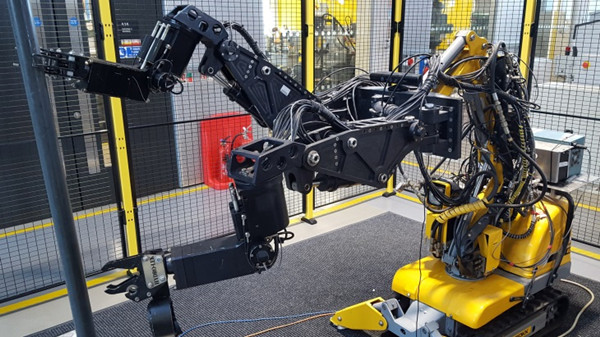Engineers at Lancaster University are developing computer systems for robots handling hazardous nuclear waste. The software will make the robots semi-autonomous - simplifying human control, which has to be done remotely due to the highly radioactive environments in which the robots operate.

Robot with two manipulating arms grasping a pipe (Image: Lancaster University)
Making use of novel imaging software and a Microsoft Kinect camera added to a mobile robot with two manipulating arms, the system makes it easier to identify, grasp and cut objects - such as metal pipes, which are a common material found in nuclear decommissioning sites.
The university said the software has the potential to significantly speed-up decommissioning operations, while also retaining human oversight of the robot.
"The standard within nuclear decommissioning is for direct human-controlled remote tele-operation of robots, which is extremely difficult for the operators particularly given the complexity of nuclear decommissioning tasks," said James Taylor, professor of control engineering at Lancaster University's Department of Engineering. "Fully autonomous solutions are unlikely to be deemed safe in the near future and so we have explored creating a semi-autonomous solution that sits between the two.
"By making use of a single camera mounted on the robot our system focusses on a common task in these harsh environments - the selecting and cutting of pipes. Our system enables an operator to instruct the robot manipulator to perform a pipe grasp and cut action with just four mouse clicks.
"Tests show that operators using this system successfully outperform operators using the current joystick-based standard. It keeps the user in control of the overall robot but significantly reduces user workload and operation time."
The system has so far been tested in laboratory conditions with a small number of operators. The researchers recognise that further testing is required, and additional measures, such as shielding, would be needed to prepare the system for radioactive environments.
The researchers have outlined their work in a paper published by the journal Robotics.
The development work was funded by the Engineering and Physical Sciences Research Council - part of UK Research and Innovation - as part of the National Centre for Nuclear Robotics (NCNR). The NCNR aims to develop advanced robotics and AI technologies for nuclear industry applications. The focus of the centre is to develop technology for aiding radioactive waste management. Lancaster University was one of eight universities that founded the NCNR.